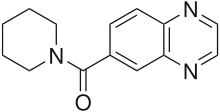Ampakine

Ampakines, also stylized as AMPAkines, are a subgroup of AMPA receptor positive allosteric modulators with a benzamide or closely related chemical structure.[1][2] They are also known as "CX compounds".[1] Ampakines take their name from the AMPA receptor (AMPAR), a type of ionotropic glutamate receptor with which the ampakines interact and act as positive allosteric modulators (PAMs) of.[1] Although all ampakines are AMPAR PAMs, not all AMPAR PAMs are ampakines.
They are currently being investigated as potential treatment for a range of conditions involving mental disability and disturbances such as Alzheimer's disease, Parkinson's disease, schizophrenia, treatment-resistant depression (TRD) or neurological disorders such as attention deficit hyperactivity disorder (ADHD), among others.[1]
More recently developed ampakine compounds are much more potent and selective for the AMPA receptor target, and while none of the newer selective ampakine compounds have yet come onto the market, various ampakines are in clinical trials.[1]
Development
A wide range of ampakines have been developed by RespireRx, which hold patents covering most medical uses of this class of drugs. The best known compounds that have come out of the RespireRx drug development program are CX-516 (Ampalex), CX-546, CX-614, CX-691 (farampator), and CX-717. ORG-26576 was developed by RespireRx but then licensed to Organon for development.
Several other compounds such as CX-701, CX-1739, CX-1763 and CX-1837 have also been announced as being under current investigation, and while little information has yet been released about them, CX-1739 is believed to be the most potent compound in this class to date, reportedly some 5x the potency of CX-717.
Presently, CX717 is in phase II clinical trials as a possible non-stimulant pharmacotherapy in the treatment of ADHD[3]. As the AMPA receptors also mediate respiratory drive, CX717 is also being investigated as a therapy in opioid-induced respiratory depression and spinal-cord injury.
Mechanism of action
Ampakines work by allosterically binding to a type of ionotropic glutamate receptor, called AMPA receptors.
The ampakines are mostly low-impact AMPAR PAMs, though with some exceptions, such as tulrampator (S-47445, CX-1632).
Side effects
Few side effects have been determined, but an ampakine called farampator (CX-691) has side effects including headache, drowsiness, nausea, and impaired episodic memory.[4]
Medical applications
An ampakine called CX456 has been proposed as a treatment for Rett syndrome, after favorable testing in an animal model.[5]
Ampakines have been investigated by DARPA for potential use in increasing military effectiveness.[6]
See also
References
- 1 2 3 4 5 Froestl W, Muhs A, Pfeifer A (2012). "Cognitive enhancers (nootropics). Part 1: drugs interacting with receptors". J. Alzheimers Dis. 32 (4): 793–887. doi:10.3233/JAD-2012-121186. PMID 22886028.
- ↑ O'Neill, M. J.; Bleakman, D.; Zimmerman, D. M.; Nisenbaum, E. S. (2004). "AMPA Receptor Potentiators for the Treatment of CNS Disorders". Current Drug Targets. CNS and Neurological Disorders. 3 (3): 181–194. doi:10.2174/1568007043337508. PMID 15180479.
- ↑ "Ampakines Platform Summary Report" (PDF).
- ↑ Wezenberg, E.; Verkes, R. J.; Ruigt, G. S.; Hulstijn, W.; et al. (2007). "Acute Effects of the Ampakine Farampator on Memory and Information Processing in Healthy Elderly Volunteers" (pdf). Neuropsychopharmacology. 32 (6): 1272–1283. doi:10.1038/sj.npp.1301257. PMID 17119538.
- ↑ Ogier, M.; Wang, H.; Hong, E.; Wang, Q.; et al. (2007). "Brain-derived Neurotrophic Factor Expression and Respiratory Function Improve after Ampakine Treatment in a Mouse Model of Rett Syndrome" (pdf). Journal of Neuroscience. 27 (40): 10912–10917. doi:10.1523/JNEUROSCI.1869-07.2007. PMID 17913925.
- ↑ Saletan, William (2008-07-16). "Night of the Living Meds: The U.S. military's sleep-reduction program". Slate. Retrieved 2012-04-05.
Further reading
- Staubli, U.; Rogers, G.; Lynch, G. (1994). "Facilitation of glutamate receptors enhances memory" (pdf). Proc Natl Acad Sci U S A. 91 (2): 777–781. doi:10.1073/pnas.91.2.777. PMC 43032. PMID 8290599.
- Staubli, U.; Perez, Y.; Xu, F. B.; Rogers, G.; et al. (1994). "Centrally active modulators of glutamate receptors facilitate the induction of long-term potentiation in vivo" (pdf). Proc Natl Acad Sci U S A. 91 (23): 11158–11162. doi:10.1073/pnas.91.23.11158. PMC 45186. PMID 7972026.
- Arai, A.; Lynch G. (1992). "Factors regulating the magnitude of long-term potention induced by theta pattern stimulation". Brain Research. 598 (1–2): 173–184. doi:10.1016/0006-8993(92)90181-8. PMID 1486479.
- Arai, A.; Silberg, J.; Kessler, M.; Lynch, G. (1995). "Effect of thiocyanate on AMPA receptor mediated responses in excised patches and hippocampal slices". Neuroscience. 66 (4): 815–827. doi:10.1016/0306-4522(94)00616-D. PMID 7544449.
- Suppiramaniam, V.; Bahr, B. A.; Sinnarajah, S.; Owens, K.; et al. (2001). "Member of the Ampakine class of memory enhancers prolongs the single channel open time of reconstituted AMPA receptors". Synapse. 40 (2): 154–158. doi:10.1002/syn.1037. PMID 11252027.
- Porrino, L. J.; Daunais, J. B.; Rogers, G. A.; Hampson, R. E.; et al. (2005). "Facilitation of task performance and removal of the effects of sleep deprivation by an ampakine (CX717) in nonhuman primates" (pdf). PLoS Biology. 3 (9): e299. doi:10.1371/journal.pbio.0030299. PMC 1188239. PMID 16104830.
- Bast, T.; da Silva, B. M.; Morris, R. G. (2005). "Distinct contributions of hippocampal NMDA and AMPA receptors to encoding and retrieval of one-trial place memory" (pdf). Journal of Neuroscience. 25 (25): 5845–5856. doi:10.1523/JNEUROSCI.0698-05.2005. PMID 15976073.
External links
- Ampakine Article Abstracts
- Recent Article About CX717
- Article on Ampakines with reference to Alzheimers
- US Patent 5,650,409
- US Patent 6,030,968
- US Patent 6,730,677
- US Patent 7,307,073
